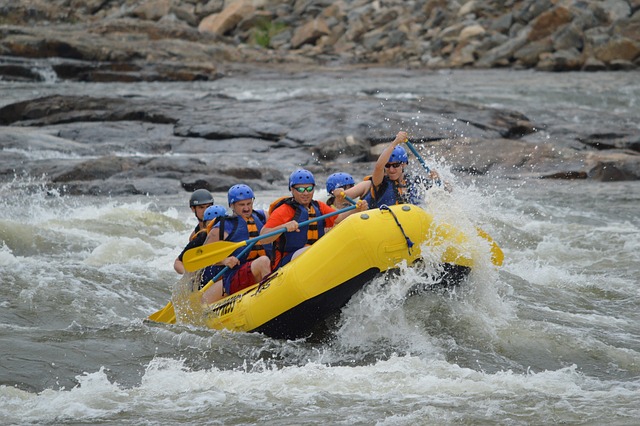Hi there! Are you tired of worrying about your belongings getting soaked during your outdoor escapades? Well, fret no more! In this post, I’m going to dive into the topic of dry bags and unravel their wonders. Whether you’re hiking through the wilderness, paddling down a river, or simply heading to the beach, dry bags are the ultimate saviors for keeping your gear safe and dry. Join me as I decode the secrets of these versatile companions and discover the must-have contents that will make your outdoor experiences even more enjoyable.
For the uninitiated, dry bags are specially designed bags made from waterproof materials to protect your belongings from water, dust, and other elements. These trusty companions come in various sizes and styles, providing a reliable and convenient way to keep your essentials safe and dry in any environment. Whether you’re facing a torrential downpour or an unexpected splash, a well-made dry bag will ensure that your gear remains perfectly dry and ready for use.
Using dry bags is not just about convenience; it’s a smart and practical choice for anyone venturing into the great outdoors. Imagine the frustration of having your phone, wallet, or extra clothes soaked and ruined, leaving you in a damp and uncomfortable situation. So, let’s dive deeper into the topic of dry bags and discover their incredible uses and must-have contents!
The Versatility of Dry Bags
These remarkable companions are not just for one specific activity but adapt to a wide range of outdoor adventures. Whether you’re camping, hiking, kayaking, or hitting the beach, dry bags offer reliable protection for your belongings, keeping them safe and dry no matter the conditions.
Here are 4 Outdoor activities where dry bags come in handy.
- Camping and hiking: Picture this – you’re out exploring the wilderness, and suddenly it starts pouring rain. Without a reliable dry bag, your sleeping bag, clothes, and other camping gear could be drenched, turning your adventure into a soggy mess. With a dry bag, you can confidently tackle the elements, knowing that your essentials are safe and dry.
- Kayaking and canoeing: Whether you’re paddling down a tranquil river or challenging whitewater rapids, water is an ever-present companion. A waterproof dry bag is a must-have for water-based activities, as it keeps your personal items, such as your phone, keys, and extra clothes, protected from the inevitable splashes and potential submersion.
- Beach trips and water sports: Lounging by the beach or engaging in thrilling water sports like snorkeling or jet skiing is a blast. However, sand, saltwater, and constant splashing can wreak havoc on your belongings. With a trusty dry bag, you can enjoy your time in the water without worrying about damaging your towels, sunscreen, electronics, or snacks.
- Traveling and backpacking: Whether you’re embarking on a cross-country road trip or backpacking through remote destinations, a dry bag becomes a reliable companion. It safeguards your valuables from rain, dust, and unexpected accidents during your journeys, allowing you to focus on making memories rather than stressing over potential damage.
Benefits of using dry bags for each activity.
- Peace of mind: With a high-quality dry bag, you can enjoy your outdoor activities with peace of mind, knowing that your belongings are protected from water, dirt, and other elements.
- Organization: Dry bags help you stay organized by providing a designated place for your gear. No more rummaging through a jumble of wet and dry items – everything has its own secure spot.
- Durability: Dry bags are typically made from tough and waterproof materials, ensuring they can withstand rugged outdoor conditions and last for many adventures to come.
- Easy to carry: Most dry bags feature comfortable straps or handles, making them easy to carry or attach to your gear. They are designed for convenience, allowing you to focus on the journey ahead.
- Versatile sizes: Dry bags come in various sizes, from small pouches for your essentials to large backpack-sized bags for extended trips. You can choose the size that best suits your needs and the duration of your adventure.
So, whether you’re camping, kayaking, hitting the beach, or traveling the world, a dry bag is your reliable companion, keeping your belongings safe, dry, and organized throughout your outdoor endeavors. In the next section, I’ll delve into the construction of dry bags, exploring the waterproof materials used and the different closure systems available.
Understanding the Construction of Dry Bags
Understanding the construction of these essential outdoor companions is key to ensuring the safety of your gear. From the waterproof materials used to the different closure systems available, I’ll unravel the secrets behind their reliable protection. Join me as I explore the construction of dry bags, equipping you with the knowledge to make informed choices and keep your belongings dry in any adventure.
Waterproof materials used
- PVC (Polyvinyl Chloride): PVC is a common material used in the construction of dry bags. It offers excellent waterproofing properties and durability, making it ideal for water-based activities. PVC dry bags are often abrasion-resistant, providing extra protection against rough surfaces.
- Nylon: Nylon is another popular material for dry bags. It is lightweight, tear-resistant, and known for its strength. Nylon dry bags are often coated with a waterproof layer, such as polyurethane (PU), to enhance their water resistance. These bags are a great choice for backpacking and hiking due to their durability and compactness.
Different closure systems
- Roll-top closure: The roll-top closure is a classic and reliable sealing mechanism for dry bags. It involves rolling down the top of the bag several times and securing it with a buckle or clip. This creates an airtight seal that keeps water out. Roll-top closures are easy to use and provide added protection against water intrusion.
- Zipper closure: Some dry bags feature a zipper closure for quick and easy access to your belongings. These bags typically have a waterproof zipper or a combination of a zipper and a roll-top closure for enhanced waterproofing. Zipper closures are convenient, but it’s crucial to ensure they are properly closed and sealed to maintain the bag’s waterproof integrity.
- Buckle closure: Buckle closures are commonly found in smaller dry bags or pouches. They provide a simple and secure way to seal the bag tightly. By fastening the buckle, you create a watertight seal that keeps moisture out and your items dry. Buckle closures are often used in conjunction with roll-top closures for added protection.
Highlight the importance of airtight seals
The key to the effectiveness of a dry bag lies in its ability to create an airtight and watertight seal. Whether it’s a roll-top closure, zipper closure, or buckle closure, ensuring a proper seal is essential to keep your gear dry. Take the time to carefully roll down the top of the bag, align the zippers, or secure the buckle tightly. Double-checking the seal before venturing into water or adverse weather conditions is crucial to prevent any surprises.
Remember, the quality of the closure system and the construction of the dry bag play a significant role in maintaining its waterproof capabilities. Investing in a well-made dry bag with reliable seals will give you the confidence to face any water-related activity without worrying about your gear getting soaked.
Next, I’ll explore the must-have contents for your dry bag. These essentials will ensure you’re prepared for any situation and have a comfortable outdoor experience.
Must-Have Contents for a Dry Bag
Pack like a pro with this guide to must-have contents for your dry bag! Whether you’re venturing into the wilderness or hitting the water, I’ve got you covered. From protecting your electronics and valuables to ensuring comfort and safety with clothing, emergency supplies, and food, I’ll reveal the essential items to include.
Electronics and valuables
- Cell phones and cameras: Our smartphones and cameras have become essential tools for capturing memories and staying connected. Keep them protected in a waterproof phone case or a small dry bag pocket to prevent water damage.
- Wallets and keys: Your wallet with identification, cash, and cards, along with your keys, should always be kept secure and dry. Place them in a waterproof pouch or a dedicated compartment in your dry bag.
- Important documents: If you’re traveling or engaging in water-based activities, it’s wise to have important documents like passports, permits, or licenses with you. Keep them in a waterproof folder or a sealed bag to ensure they stay dry and intact.
Clothing and personal items
- Extra clothes and socks: Pack a change of clothes and extra socks, especially if you anticipate getting wet or encountering changing weather conditions. Seal them in a waterproof bag to keep them dry and ready to wear.
- Toiletries and medications: Don’t forget your toiletries and any necessary medications. Place them in leak-proof containers or waterproof pouches to prevent spills and keep them dry.
- Towels and swimwear: If you’re heading to the beach or planning water activities, pack a compact and quick-drying towel. Additionally, bring along your swimwear in a waterproof bag, so you’re always ready for a refreshing dip.
Emergency supplies
- First aid kit: Accidents happen, so having a well-stocked first aid kit is crucial. Include items like adhesive bandages, antiseptic wipes, pain relievers, and any specific medications you might need.
- Whistle and flashlight: These compact and lightweight emergency tools can be lifesavers. A whistle can attract attention in case of an emergency, while a flashlight helps navigate in low-light situations. Keep them readily accessible in your dry bag.
- Emergency food and water: Pack some non-perishable snacks like energy bars and trail mix, as well as a collapsible water bottle or water purification tablets. These supplies can sustain you in unexpected situations or extended outings.
Food and drinks
- Non-perishable snacks: Keep your energy levels up with a stash of non-perishable snacks like granola bars, dried fruits, nuts, or jerky. These lightweight and compact snacks are perfect for on-the-go adventures.
- Reusable water bottles: Hydration is essential, so bring a sturdy and reusable water bottle to stay refreshed throughout your activities. Look for bottles that are designed to be leak-proof and durable.
- Utensils and meal packs: If you plan on having meals during your outdoor excursions, consider packing lightweight utensils and pre-packaged meal options that require minimal preparation. This way, you can enjoy a satisfying meal without worrying about food spoilage.
In the next section, I’ll provide you with useful tips on how to pack and organize your dry bag efficiently. Stay tuned!
(Note: Ensure that you adapt the list of must-have contents based on the specific activities you are engaging in and the duration of your trip.)
Tips for Packing and Organizing a Dry Bag
- Utilize packing cubes and compartments: To optimize space and keep your belongings organized, consider using packing cubes or dry bag compartments. These handy accessories help separate items and prevent them from shifting around inside the bag. Pack similar items together, such as electronics in one cube, clothing in another, and toiletries in a separate compartment.
- Prioritize items based on accessibility needs: Think about the items you may need to access frequently during your adventure. Place them towards the top or in easily accessible pockets of your dry bag. For example, your phone, snacks, or a waterproof map should be within reach, while items like extra clothes can be placed towards the bottom.
- Use waterproof bags for additional protection: For added peace of mind, consider using individual waterproof bags or pouches for specific items, even inside your dry bag. This extra layer of protection can provide an additional barrier against water intrusion. Place items like electronics, documents, or toiletries in these waterproof bags to ensure their utmost protection.
- Avoid overpacking and maintain proper weight distribution: While it’s tempting to bring everything you think you might need, try to pack only the essentials to avoid overloading your dry bag. Overpacking can make it difficult to find items quickly and affect the bag’s waterproofing. Additionally, distribute the weight evenly to maintain balance and ease of carrying.
Remember, organizing your dry bag efficiently not only keeps your belongings easily accessible but also helps in maintaining the bag’s waterproof integrity. By implementing these tips, you’ll be ready to tackle any adventure with a well-organized and functional dry bag.
Maintaining and Cleaning Your Dry Bag
Discover how to maintain the waterproof integrity and cleanliness of your dry bag, so it’s always ready for your next adventure. Just like any gear, proper care ensures its longevity and optimal performance. From drying and storing to removing dirt and odor, I’ll guide you through the essential steps.
Proper care instructions for different materials
- PVC dry bags: To clean a PVC dry bag, rinse it with fresh water after each use to remove any salt or dirt. Use a mild soap or detergent if necessary, but avoid harsh chemicals or abrasive scrubbing. Allow the bag to air dry completely before storing it to prevent mold or mildew growth.
- Nylon dry bags: Nylon dry bags are generally easy to clean. Gently scrub the surface with a soft brush or sponge and mild soap, paying attention to any stains or dirt. Rinse thoroughly with fresh water and ensure the bag is completely dry before storing.
Tips for drying and storing the dry bag
- Dry thoroughly: After cleaning or using your dry bag in wet conditions, make sure to dry it thoroughly before storing it. Hang it upside down in a well-ventilated area or use a drying rack to allow air circulation. Avoid storing a damp or wet bag, as it can lead to unpleasant odors or mold growth.
- Store in a cool, dry place: When not in use, store your dry bag in a cool and dry place. Avoid exposing it to direct sunlight or extreme temperatures, as these can affect the material’s integrity. Consider using a storage sack or a dedicated area to keep your dry bag protected and ready for your next adventure.
Cleaning methods to remove dirt and odor
- Mild soap and water: For general cleaning, use a mild soap or detergent and water solution. Gently scrub the bag’s exterior and interior, focusing on areas with dirt or stains. Rinse thoroughly to remove any soap residue.
- Vinegar solution: If your dry bag has a persistent odor, mix a solution of water and vinegar (1 part vinegar to 3 parts water) and wipe down the bag’s interior. Let it sit for a few minutes before rinsing it with fresh water. The vinegar helps neutralize odors naturally.
- Baking soda: For stubborn odors, sprinkle baking soda inside the dry bag and let it sit overnight. Shake out the excess baking soda and rinse the bag thoroughly with water. Baking soda helps absorb and eliminate odors effectively.
In the next section, I’ll explore some additional features to consider when choosing a dry bag, which can enhance your outdoor experience and convenience.
Additional Features to Consider
Beyond its waterproofing capabilities, there are additional features that can elevate your outdoor experience. From reflective details for enhanced visibility to multiple compartments for better organization, I’ll explore the exciting options. Join me as I dive into the world of additional features, helping you choose the perfect dry bag that goes beyond basic protection and enhances your outdoor adventures.
Reflective details for visibility
Some dry bags come with reflective strips or details. These features enhance visibility in low-light conditions, making it easier for others to spot you, especially if you’re participating in activities like night hiking or paddling. Consider a dry bag with reflective elements for added safety.
Attachment points and straps for convenience
Look for dry bags that have attachment points or straps. These allow you to secure the bag to your kayak, canoe, or backpack, keeping it easily accessible and preventing it from shifting or falling off during your outdoor adventures. Additionally, attachment points can be used to connect other gear or accessories.
Integrated waterproof phone cases and speakers
For those who rely heavily on their smartphones for navigation or entertainment, consider a dry bag with an integrated waterproof phone case. These cases offer protection while still allowing you to use the touchscreen and camera. Some dry bags even feature built-in waterproof speakers, so you can enjoy music while keeping your phone dry and secure.
Multiple compartments and pockets
Having multiple compartments or pockets in your dry bag can help you stay organized. It allows you to separate items by category, making it easier to find what you need quickly. Look for dry bags with interior and exterior pockets, mesh compartments, or dividers to maximize organization and accessibility.
Size and capacity options
Dry bags come in various sizes and capacities. Consider the duration of your outdoor activities and the amount of gear you typically carry. Smaller dry bags are great for day trips or carrying just the essentials, while larger bags are suitable for longer expeditions or if you need to pack bulkier items like sleeping bags or camping gear.
Durability and quality construction
When selecting a dry bag, prioritize durability and quality construction. Look for reinforced seams, sturdy materials, and reliable closures. A well-made dry bag will withstand the rigors of outdoor activities and provide long-lasting protection for your belongings.
Remember to assess your specific needs and preferences when considering these additional features. Each feature can enhance your overall outdoor experience and make your dry bag even more versatile and convenient.
Conclusion
In conclusion, dry bags are the unsung heroes of outdoor adventures, providing reliable protection for your gear and peace of mind in any environment. From camping trips to water sports, these versatile companions ensure your belongings stay safe and dry. I’ve explored their construction, must-have contents, maintenance, and additional features, equipping you with the knowledge to make informed choices.
So, whether you’re embarking on a rugged hike, kayaking down a river, or lounging on a sandy beach, don’t forget to pack your trusty dry bag. It’s the ultimate solution to keep your valuables, clothing, and emergency supplies protected from water, dirt, and unexpected surprises.
Investing in a high-quality dry bag is an investment in your outdoor experiences. It’s a gateway to worry-free adventures and unforgettable memories. So, gear up, pack smart, and let your dry bag be your reliable companion on every journey.
Get ready to embrace the great outdoors with confidence, knowing that your gear is shielded from the elements. It’s time to decode the wonders of dry bags and embark on your next adventure with peace of mind. Happy exploring!








